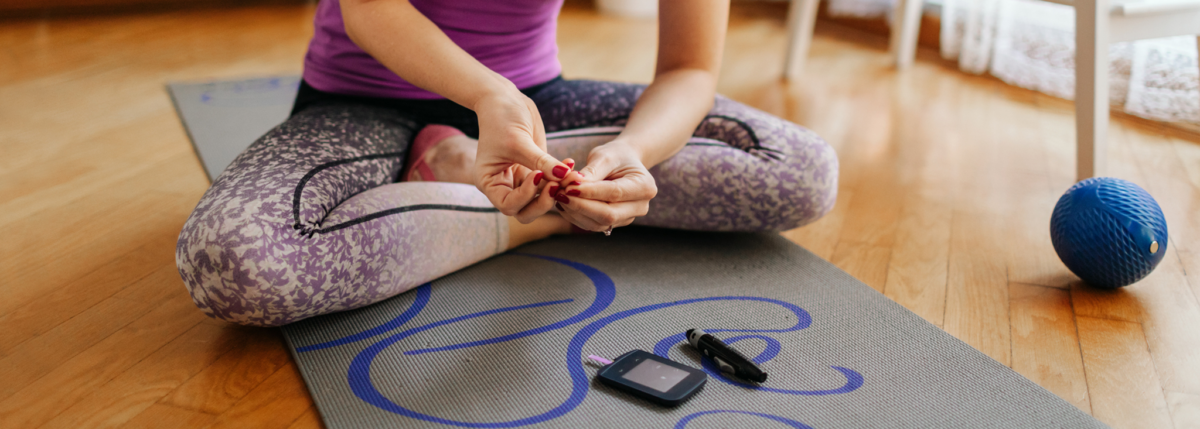HOW TO BALANCE YOUR INSULIN DOSE WITH YOUR EXERCISE
Exercise has a big impact on your blood-sugar levels. That is why it is important to balance your insulin dose with your exercise
There’s no simple formula—or rule—for balancing an insulin dose when you exercise with diabetes. That is because the type of exercise you enjoy—and how your body and health responds to it—is unique to you.
However, knowing which exercises cause low and high blood sugars is helpful. For example:
- Aerobic exercise—like jogging, cycling or swimming—puts you at risk of hypoglycemia (low blood sugar).
- Anaerobic exercise—like weightlifting, sprinting or high-intensity interval training (HIIT)—can put you at risk of hyperglycemia (high blood sugar), especially if your blood-sugar levels are elevated before starting exercise.
Because both insulin and exercise affect blood-sugar levels, you’ll need to know how to balance your insulin dose with your exercise routine.
Remember though—your own insulin needs may vary. So, talk to your healthcare team to help you make adjustments!
How to Avoid Low Blood Sugars During Your Exercise
Crashing mid-workout because of a low blood sugar can be frustrating and demotivating.
With “fasted exercise,” you can reduce the risk of going low.
Fasted exercise is exercising first thing in the morning before eating or taking an insulin bolus.
A fasted exercise is also an exercise after not eating for around 10-14 hours.
Your body mostly burns glucose for fuel when you take a rapid-acting insulin bolus with a meal before working out. Fasted exercise, however, makes your body use fat for energy instead, which reduces your risk of having a low.
After the following types of high-intensity exercise, try having an immediate post-workout protein shake or meal:
- Weight lifting
- HIIT
- Endurance training like long-distance running or cycling
- Any intense exercise over 60 minutes
- High-intensity competitive sports like soccer, tennis or racquet ball
If you often go low during fasted exercise, this could be because your basal (background) insulin dose is a bit high and needs to be adjusted.
For example: If you take 12 units of Lantus (long-acting insulin) at night and go low during your next-morning’s fasted exercise, taking 11 units instead might help you prevent those lows.
If you’re just a bit low when you wake up, try eating a small amount of carbs without an insulin bolus, and exercising—if it feels safe.
For example: For low- to moderate-intensity aerobic exercise lasting between 30 to 60 minutes in a fasted state, 10 to 15 grams of carbs may help prevent low blood sugar.
What if Fasted Exercise Isn’t For Me?
If fasted exercise isn’t feasible, don’t sweat it! You might just need to adjust your meal timing and insulin dose.
Exercising within three hours after eating and taking a full insulin bolus can cause low blood sugar. Therefore, you may need to adjust your insulin dose.
The type of exercise you choose—e.g., walking vs. jogging vs. lifting weights—the duration and intensity can affect how much you’ll need to reduce your insulin.
How Do I Adjust My Insulin Dose If I Eat Before Working Out?
If you want to eat before exercising, you may need to reduce the amount of insulin you normally take for a meal.
If you exercise within 2 to 3 hours of taking a bolus, reducing your normal insulin dose by 25 to 75 percent—depending on the type, intensity and duration of exercise—reduces your risk of low blood sugar.
For example:
- If you’re going for a 30-minute walk after lunch (mild aerobic exercise), you might need to cut your lunch bolus by 25 percent—or 1/4 unit of Novolog (fast-acting insulin) if you normally take 1 unit with a meal.
- If you’re going for a 60-minute jog (moderate aerobic exercise), you might cut your lunch bolus by 75 percent—or ¼ unit of Novolog if you normally take 1 unit with a meal.
You may also need less insulin—both fast-acting and long-acting—if you engage in endurance training.
Talk to your healthcare team if you’re planning on starting endurance training. After taking your normal insulin bolus with a meal, prolonged aerobic exercise can lower your blood sugars even more than shorter bouts of exercise.
How to Avoid High Blood Sugar During Your Exercise
If exercise makes blood sugars burn faster, how is it possible to go high when working out?
Good question!
A few reasons why high blood sugars during exercise can happen are because:
- Anaerobic exercise can make your body convert lactic acid to glucose for fuel.
- The adrenaline you produce during competitive sports tells your liver to release stored glucose for extra energy.
If you start in your target range—which should ideally be between 90 mg/dL and 250 mg/dL before exercise—a spike in blood sugar during exercise could be caused by:
- A basal insulin dose that needs to be corrected.
- The type of exercise you’re doing.
- Hormones related to dawn phenomenon or caffeine.
If you go high while working out, you might need a small bolus of rapid-acting insulin mid-exercise or to cool down with a lower-intensity aerobic exercise. You should stop exercising if your blood sugar levels rise above 250 mg/dL.
Take Out the Guesswork by Logging Your Insulin Doses!
You might have heard of logging insulin—i.e. keeping track of all your insulin doses and blood-sugar readings—which can help you understand how insulin impacts your body and adjust doses.
Adding exercise to your record keeping can help you fine -une insulin doses even more.
And yes—this can take a lot of trial and error, not to mention patience!
In the end, it’s worth it though. Exercise is not only healthy for you, but it can also help you manage your blood sugar and relieve stress!
Remember:
-
- A routine—including record keeping—is your friend.
- Always be prepared for lows with fast-acting carbs or emergency glucagon.
- You’re not alone! Ask your healthcare team to help you spot patterns and make adjustments.
This content was made possible by Lilly, a Founding Partner of Beyond Type 2.
Beyond Type 2 maintains editorial control over its content.





